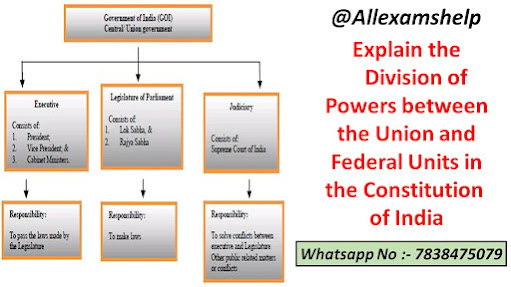The Constitution of India divides powers between the Union (federal) and State governments to ensure a balance of power and promote cooperative federalism. The division of powers is enshrined in the Seventh Schedule of the Constitution, which lists the subjects under the exclusive jurisdiction of the Union and State governments.
The Union List
includes subjects of national importance such as defense, foreign affairs,
currency, and communication. The Union government has the exclusive power to
make laws on these subjects.
Explain the Division of
Powers between the Union and Federal Units in the Constitution of India
The State List
includes subjects of local importance such as police, public health,
agriculture, and trade within the state. The State government has the exclusive
power to make laws on these subjects.
The Concurrent
List includes subjects that are of shared responsibility between the Union and
State governments, such as education, forest, and wildlife. Both the Union and
State governments can make laws on these subjects, but in case of a conflict,
the Union law prevails.
The
Constitution also empowers the Union government to make laws on subjects that
are not explicitly mentioned in any of the three lists but are necessary for
the governance of the country as a whole. This is known as the residuary power.
In addition to
the above, the Constitution also provides for the formation of Union
Territories and the power of the President to declare a state of emergency in
case of a threat to the security of the country.
Overall, the
division of powers between the Union and State governments is an essential
feature of the Indian federal system and helps to maintain a balance of power
between the two levels of government while promoting cooperative federalism.
The
Constitution of India provides for a federal system of government, which means
that power is divided between the Union (federal) government and the State
governments. The Constitution defines the following federal units in India:
States: India
has 28 States as of 2023, each with its own elected government, legislature,
and judiciary. The States have the power to make laws on subjects specified in
the State List of the Seventh Schedule of the Constitution.
Union
Territories: India has 8 Union Territories as of 2023, which are administered
by the President through an appointed administrator. The Union Territories do
not have a separate elected government, and the Union government has a greater
degree of control over their administration.
Special
Category States: Some States have been classified as Special Category States
based on their economic and social backwardness. These States are eligible for
additional financial assistance from the Union government.
Autonomous
Regions: The Constitution also provides for the creation of autonomous regions
within a State to give greater autonomy to certain regions with distinct
cultural or linguistic identities.
Overall, the
federal units in India reflect the country's diverse culture and regional identities
and help to ensure a balance of power between the Union and State governments.
The Indian
Constitution divides powers between the Union (federal) and State governments
to ensure a balance of power and promote cooperative federalism. The division
of powers is enshrined in the Seventh Schedule of the Constitution, which lists
the subjects under the exclusive jurisdiction of the Union and State
governments.
The Union List
includes subjects of national importance such as defense, foreign affairs,
currency, and communication. The Union government has the exclusive power to
make laws on these subjects.
The State List
includes subjects of local importance such as police, public health,
agriculture, and trade within the state. The State government has the exclusive
power to make laws on these subjects.
The Concurrent
List includes subjects that are of shared responsibility between the Union and
State governments, such as education, forest, and wildlife. Both the Union and
State governments can make laws on these subjects, but in case of a conflict,
the Union law prevails.
For SOLVED PDF & Handwritten
WhatsApp No :- 7838475019
The
Constitution also empowers the Union government to make laws on subjects that
are not explicitly mentioned in any of the three lists but are necessary for
the governance of the country as a whole. This is known as the residuary power.
In addition to
the above, the Constitution also provides for the formation of Union
Territories and the power of the President to declare a state of emergency in
case of a threat to the security of the country.
Overall, the
division of powers between the Union and State governments is an essential
feature of the Indian federal system and helps to maintain a balance of power
between the two levels of government while promoting cooperative federalism.
